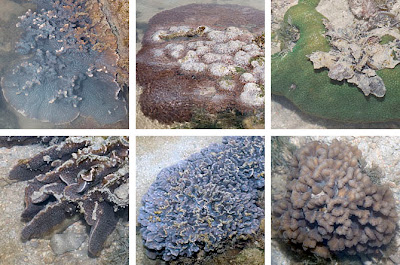We had a brief look at Big Sisters Island before we got caught in a fierce rain in high winds.
Big Sisters Island has lovely living reefs, and lies across a deep narrow channel from Little Sisters Island. Fortunately, I didn't see signs of mass coral bleaching today.
On the way to Sisters Island we dropped off another passenger to the City of Beijing, a ship parked in Singapore waters. So here's the City of Singapore next to the City of Beijing!
The Fluted giant clam (Tridacna squamosa) we saw during my last trip in May 2013 was still alive and well! I also came across a Giant top shell snail (Trochus niloticus).
We commonly see the Spider conch (Lambis lambis) on this island.
I came across a three-some of Glossodoris atromarginata nudibranchs! I'm not sure what these nudibranchs are up to. Mating? Feeding?
Many of the corals were covered with acoel flatworms. Many of the corals had Fan worms (Family Sabellidae) growing on them.
As usual, the most abundant kind of corals were Pore corals (Porites sp.) and Favid corals (Family Faviidae). Almost all of those I saw were alright, except for some ill Pore corals and some Favid corals with small pale patches.
There are many different kinds of hard corals on Big Sisters Island, and most that I saw were alright: several large blue Ridged plate corals (Merulina sp.), the huge Anemone corals (Goniopora sp.) growing in the middle of the lagoon, Lettuce corals (Pavona sp.), Carnation corals (Pectinia sp.).
I saw several Crinkled sandpaper coral (Psammocora sp.) and checked on the Brain anchor coral (Euphyllia ancora). They seemed alright. These species were among the first to bleach during the global coral bleaching event of 2010. I didn't see any Cauliflower corals (Pocillopora sp.).
I came across 8 Circular mushroom corals (Family Fungiidae) all about small to medium sized. None of them were bleaching. While some of those I saw in May 2013 were bleaching.
There were only a handful of corals that were very pale, the corals were of various kinds: a Favid coral (Family Faviidae), one Flowery disk coral (Turbinaria sp.), a small Ridged plate coral (Merulina sp.) one small colony of Anemone corals (Goniopora sp.).
Some of the corals I saw were rather pale or strange pastel shades, the corals were of various kinds: a Favid coral (Family Faviidae), Ridged plate coral (Merulina sp.), Thin disk coral (Turbinaria sp.), and several large colonies of Brain coral (Family Mussidae).
One Giant carpet anemones (Stichodactyla gigantea) I saw was bleaching. But all the other anemones I saw seemed alright. I saw many Frilly sea anemones (Phymanthus sp.).
The Leathery soft corals (Family Alcyoniidae) I saw seemed mostly alright, with only a few being a little pale. But there aren't many leathery soft corals on Big Sisters Island. I didn't come across any flowery soft corals (Family Nephtheidae).
Running back to shelter from the rain, I had a quick look at the corals facing Little Sisters Island and I didn't see any obvious bleaching.
This Pore coral (Porites sp.) seems to be very ill (bluish portions) and half dead (light brown portions). The healthy portions are dark brown. I saw corals in a similar situation in May 2013 and also last year May 2012.
Many of the clumps of branching sponge seem to be encrusted by some fuzzy stuff.
All the Sargassum seaweed (Sargassum sp.) has disappeared from the shore, to be replaced by a bloom of Bryopsis seaweed (Bryopsis sp.) in the deeper areas. Alas, none of us came across any seahorses. Just as we were into the second half of our field trip, ominous weather built up across the water. Because of the rain, I didn't get check on the seagrasses on this shore.
We took shelter on the jetty which we felt was the safest spot as we notice huge fallen trees on the island during our last trip in May 2013. It's really tough to put on a poncho in the ferocious winds that blew. As Pei Yan demonstrates, with Rene taking lots of photos of the process.
When we reached the mainland, once again, I saw brown runoff leaving the mainland after the heavy downpour. This kind of 'brown flood at sea' seems to happen everytime there is heavy rain.
Sedimentation is really bad for marine life as it clogs up delicate feeding and breathing parts, and blocks out the sunlight which many animals depend on, especially animals that harbour symbiotic algae (zooxanthellae) which make food from sunlight and share the food with their animal hosts. These include corals.
Trips to the shores continue over the next few days, but with a focus on mangroves for me as the spring tides are no longer as low. There's too many shores to cover and too few low tides!




















